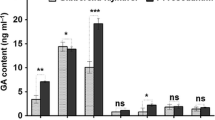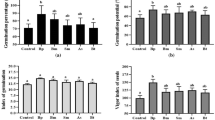Abstract
Brassinosteroids are well known to mitigate biotic stresses; however, their role to induce tolerance against Verticillium dahliae is unknown. The current study employed V. dahliae (Vd) toxin as pathogen-free model system to induce stress on cotton callus growth, and its amelioration was investigated using 24-epibrassinolide (EBR). Results revealed that EBR has ameliorative effects against Vd toxin with greater seen effect when callus was treated with EBR prior to its exposure to Vd toxin (pre-EBR treatment) than EBR applied along with Vd toxin simultaneously (co-EBR treatment). Pre-EBR-treated calli remained green, while 65 and 90% callus browning was observed in co-EBR- and Vd toxin-alone-treated callus, respectively. Likewise, the fresh weight of the pre-EBR-treated callus was 52% higher than Vd toxin-alone treatment, whereas this increase was only 23% in co-EBR-treated callus. Meanwhile, EBR treatment of the cotton callus has also increased the contents of chlorophylls a and b, carotenoids, total phenols, flavonoids, soluble sugars, and proteins and increased the activity of enzymes involved in secondary metabolism like polyphenol oxidase (PPO), phenylalanine ammonialyase (PAL), cinnamyl alchol dehydrogenase (CAD), and shikimate dehydrogenase (SKDH) over Vd toxin-alone treatment with higher increments being observed in pre-EBR-treated callus. Furthermore, EBR treatment mimicked the DNA damage and improved the structure of mitochondria, granum, stroma thylakoids, and the attachment of ribosomes with the endoplasmic reticulum. This EBR-mediated mitigation was primarily associated with substantially increased contents of photosynthetic pigments and regulation of secondary metabolism.








Similar content being viewed by others
Abbreviations
- BL:
-
Brassinolide
- BRs:
-
Brassinosteroid
- CAD:
-
Cinnamyl alchol dehydrogenase
- EBR:
-
24-Epibrassinolide
- PAL:
-
Phenylalanine ammonialyase
- PPO:
-
Polyphenol oxidase
- SKDH:
-
Shikimate dehydrogenase
- TSP:
-
Total soluble protein
- TSS:
-
Total soluble sugars
- TP:
-
Total phenols
- TEM:
-
Transmission electron microscope
- Vd:
-
Verticillium dahlia
References
Ahammed GJ, Gao CJ, Ogweno JO, Zhou YH, Xia XJ, Mao WH, Shi K, Yu JQ (2012) Brassinosteroids induce plant tolerance against phenanthrene by enhancing degradation and detoxification in Solanum lycopersicum L. Ecotoxicol Environ Saf 80:28–36
Ahammed G, Zhou Y, Xia X, Mao W, Shi K, Yu J (2013) Brassinosteroid regulates secondary metabolism in tomato towards enhanced tolerance to phenanthrene. Biologia Planta 57:154–159
Ahmed IM, Dai H, Zheng W, Cao F, Zhang GP, Sun D, Wu FB (2013) Genotypic differences in physiological characteristics in the tolerance to drought and salinity combined stress between Tibetan wild and cultivated barley. Plant Physiol Biochem 63:49–60
Ahmed IM, Nadira UA, Bibi N, Cao F, He X, Zhang GP, Wu FB (2015) Secondary metabolism and antioxidants are involved in the tolerance to drought and salinity, separately and combined, in tibetan wild barley. Environ Exp Bot 111:1–12
Arnon DI (1949) Copper enzymes in isolated chloroplasts. Polyphenoloxidase in Beta vulgaris. Plant Physiol 24(1):1–15
Atanassova M, Georgieva S, Ivancheva K (2011) Total phenolic and total flavonoid contents, antioxidant capacity and biological contaminants in medicinal herbs. J Uni Chem Tech Metall 46:81–88
Bate NJ, Orr J, Ni W, Meromi A, Nadler-Hassar T, Doerner PW, Dixon RA, Lamb CJ, Elkind Y (1994) Quantitative relationship between phenylalanine ammonia-lyase levels and phenylpropanoid accumulation in transgenic tobacco identifies a rate-determining step in natural product synthesis. Proc Natl Acad Sci U S A 91:7608–7612
Benhamou N, Grenier J, Chrispeels MJ (1991) Accumulation of β-fructosidase in the cell walls of tomato roots following infection by a fungal wilt pathogen. Plant Physiol 97:739–750
Bibi N, Zhang GX, Li F, Kai F, Yuan SN, Wang XD (2013) Utilization of Vd toxin for rapid screening of cotton germplasm against Verticillium dahliae Pak. J Bot 45(6):2157–2162
Bibi N, Kai F, Muhammad D, Nawaz G, Yuan SN, Wang XD (2014) Exogenous application of epibrassinolide attenuated Verticillium wilt in upland cotton by modulating the carbohydrates metabolism, plasma membrane ATPases and intracellular osmolytes. Plant Growth Regul 73:155–164
Bradford M (1976) Protein measurement with the Folin phenol reagent. Biochemist 72:248–254
Camacho-Cristóbal JJ, Anzellotti D, González-Fontes A (2002) Changes in phenolic metabolism of tobacco plants during short-term boron deficiency. Plant Physiol Biochem 40:997–1002
Choudhary SP, Oral HV, BhardwajR YJQ, Tran LSP (2012) Interaction of brassinosteroids and polyamines enhances copper stress tolerance in Raphanus sativus. J Exp Bot 63:5659–5675
Cui Y, Bell AA, Joost O, Magill C (2000) Expression of potential defense response genes in cotton. Physiol Mol Plant Pathol 56:25–31
Dhaubhadel S, Browning KS, Gallie DR, Krishna P (2002) Brassinosteroid functions to protect the translational machinery and heat-shock protein synthesis following thermal stress. Plant J 29:681–691
Díaz J, Merino F (1998) Wound-induced shikimate dehydrogenase and peroxidase related to lignification in pepper (Capsicum annuum L.) leaves. J Plant Physiol 152:51–57
Ding J, Shi K, Zhou YH, Yu JQ (2009) Effects of root and foliar applications of 24-epibrassinolide on Fusarium wilt and antioxidant metabolism in cucumber roots. Hortic Sci 44:1340–1345
Dixon RA, Paiva NL (1995) Stress-induced phenylpropanoid metabolism. Plant Cell 7:1085
Fradin EF, Thomma BP (2006) Physiology and molecular aspects of Verticillium wilt diseases caused by V. dahliae and V. albo-atrum. Mol Plant Pathol 7:71–86
Fritig B, Kauffmann S, Dumas B, Geoffroy M, Kopp M, Legrand M (1987) In: Evered D, Harnett S (eds) Mechanism of the hypersensitivity reaction of plants, plant resistance to viruses. Wiley, Chichester, pp 92–108
Gallet C, Després L, Tollenaere C (2004) Phenolic response of Trollius europaeus to Chiastocheta invasion. Polyphenol Commun 759–760
Glazebrook J (2005) Contrasting mechanisms of defense against biotrophic and necrotrophic pathogens. Annu Rev Phytopathol 43:205–227
Goicoechea N, Aguirreolea J, Cenoz S, Garcia-Mina J (2000) Verticillium dahliae modifies the concentrations of proline, soluble sugars, starch, soluble protein and abscisic acid in pepper plants. Eur J Plant Pathol 106:19–25
Gomes M (2011) Physiological effects related to brassinosteroid application in plants, Brassinosteroids: a class of plant hormone, 193–242
Gudesblat GE, Russinova E (2011) Plants grow on brassinosteroids. Curr Opin Plant Biol 14:530–537
Kaur H, Shaker K, Heinzel N, Ralph J, Gális I, Baldwin IT (2012) Environmental stresses of field growth allow cinnamyl alcohol dehydrogenase-deficient Nicotiana attenuata plants to compensate for their structural deficiencies. Plant Physiol 159:1545–1570
Kawchuk LM, Hachey J, Lynch DR, Kulcsar F, Van Rooijen G, Waterer DR, Robertson A, Kokko E, Byers R, Howard RJ (2001) Tomato Ve disease resistance genes encode cell surface-like receptors. Proc Natl Acad Sci U S A 98:6511–6515
Khripach V, Zhabinskii V, de Groot A (2000) Twenty years of brassinosteroids: steroidal plant hormones warrant better crops for the XXI century. Ann Bot 86:441–447
Klosterman SJ, Subbarao KV, Kang S, Veronese P, Gold SE, Thomma BP, Chen Z, Henrissat B, Lee YH, Park J (2011) Comparative genomics yields insights into niche adaptation of plant vascular wilt pathogens. PLoS Pathog 7:e1002137
Krishna P (2003) Brassinosteroid-mediated stress responses. J Plant Growth Regul 22:289–297
Li YZ, Zheng XH, Tang HL, Zhu JW, Yang JM (2003) Increase of ß-1, 3-glucanase and chitinase activities in cotton callus cells treated by salicylic acid and toxin of Verticillium dahlia. Acta Bot Sin 45(7):802–808
Menke M, Chen I, Angelis KJ, Schubert I (2001) DNA damage and repair in Arabidopsis thaliana as measured by the comet assay after treatment with different classes of genotoxins. Muta Res Genet Toxic Environ Mutagen 493:87–93
Mitchell HJ, Hall J, Barber MS (1994) Elicitor-induced cinnamyl alcohol dehydrogenase activity in lignifying wheat (Triticum aestivum L.) leaves. Plant Physiol 104:551–556
Nakashita H, Yasuda M, Nitta T, Asami T, Fujioka S, Arai Y, Sekimata KS, Takatsuto S, Yamaguchi I, Yoshida S (2003) Brassinosteroid functions in a broad range of disease resistance in tobacco and rice. Plant J 33:887–898
Ramamoorthy V, Raguchander T, Samiyappan R (2002) Enhancing resistance of tomato and hot pepper to Pythium diseases by seed treatment with fluorescent pseudomonads. Euro J Plant Pathol 108:429–441
Sasse J (2003) Physiological actions of brassinosteroids: an update. J Plant Growth Regul 22:276–288
Shi K, Chen ZX, Yu JQ (2012) Hydrogen peroxide functions as a secondary messenger for brassinosteroids-induced CO2 assimilation and carbohydrate metabolism in Cucumis sativus. J ZJU Sci B 13:811–823
Singleton VL, Orthofer R, Lamuela-Raventos RM (1999) Analysis of total phenols and other oxidation substrates and antioxidants by means of Folin-Ciocalteu reagent. Methods Enzymol 299:152–178
Wang JY, Cai Y, Gou JY, Mao YB, Xu YH, Jiang WH, Chen XY (2004) VdNEP, an elicitor from Verticillium dahliae, induces cotton plant wilting. Appl Environ Microbiol 70:4989–4995
Wang C, Lu J, Zhang S, Wang P, Hou J, Qian J (2011) Effects of Pb stress on nutrient uptake and secondary metabolism in submerged macrophyte Vallisneria natans. Ecotoxicol Environ Saf 74:1297–1303
Wu XX, Ding HD, Zhu ZW, Yang SJ, Zha DS (2012) Effects of 24-epibrassinolide on photosynthesis of eggplant (Solanum melongena L.) seedlings under salt stress. Afr J Biotechnol 11:8665–8671
Xia XJ, Wang YJ, Zhou YH, Tao Y, Mao WH, Shi K, Asami T, Chen Z, Yu JQ (2009) Reactive oxygen species are involved in brassinosteroid-induced stress tolerance in cucumber. Plant Physiol 150:801–814
Xia XJ, Zhou YH, Ding J, Shi K, Asami T, Chen Z, Yu JQ (2011) Induction of systemic stress tolerance by brassinosteroid in Cucumis sativus New Phytol 191:706-720 Xu L, Zhu L, Tu L, Liu L, Yuan D, Jin L, Long L, Zhang X (2011) Lignin metabolism has a central role in the resistance of cotton to the wilt fungus Verticillium dahliae as revealed by RNA-Seq-dependent transcriptional analysis and histochemistry. J Exp Bot 62:5607–5621
Yemm E, Willis A (1954) The estimation of carbohydrates in plant extracts by anthrone. Biochem J 57:508
Zhang H, Wang X, Shao M, Yuan S, Ni M (2010) Expression of alfalfa antifungal peptide gene and enhance of resistance to Verticillium dahliae in upland cotton. Acta Agric Scand Sect B–Soil Plant Sci 60:95–100
Zhaoqing C, Junwei J, Xiangjun Z, Xiaoya C (1999) Isolation of glycoproteins from Verticillium dahliae and their phytotoxicity. Acta Bot Sinica 41:972–976
Zhen XH, Li YZ (2004) Ultrastructural changes and location of β-1, 3-glucanase in resistant and susceptible cotton callus cells in response to treatment with toxin of Verticillium dahlia and salicylic acid. J Plant Physiol 161:1367–1377
Zhu JK (2002) Salt and drought stress signal transduction in plants. Annu Rev Plant Biol 53:247
Acknowledgments
The author and co-author of the manuscript are thankful to Postdoctoral Scientific Research Foundation of Zhejiang Province: Bsh1202088 to carry this study.
Author information
Authors and Affiliations
Corresponding author
Ethics declarations
The authors declare that they have no competing interest.
Additional information
Responsible editor: Yi-ping Chen
Rights and permissions
About this article
Cite this article
Bibi, N., Ahmed, I.M., Fan, K. et al. Role of brassinosteroids in alleviating toxin-induced stress of Verticillium dahliae on cotton callus growth. Environ Sci Pollut Res 24, 12281–12292 (2017). https://doi.org/10.1007/s11356-017-8738-6
Received:
Accepted:
Published:
Issue Date:
DOI: https://doi.org/10.1007/s11356-017-8738-6




